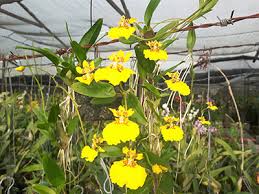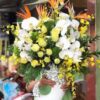# Organizing a Workshop on Caring for Dancing Lady Orchids (*Oncidium*): A Comprehensive Guide

Dancing Lady Orchids, scientifically known as *Oncidium*, are admired for their vibrant colors and unique floral shapes, resembling graceful dancers. As interest in these exquisite plants grows, so does the need for proper education on their care. Organizing a workshop on caring for Dancing Lady Orchids can empower enthusiasts with the knowledge and skills necessary to cultivate these beautiful orchids successfully. This article outlines the steps to plan, execute, and evaluate an effective workshop, ensuring participants leave with practical insights and a passion for *Oncidium* orchids.
## Table of Contents
1. [Understanding the Importance of the Workshop](#understanding-the-importance-of-the-workshop)
2. [Defining the Workshop Objectives](#defining-the-workshop-objectives)
3. [Selecting the Right Venue](#selecting-the-right-venue)
4. [Gathering Educational Materials](#gathering-educational-materials)
5. [Designing the Workshop Agenda](#designing-the-workshop-agenda)
6. [Promoting the Workshop](#promoting-the-workshop)
7. [Executing the Workshop](#executing-the-workshop)
– 7.1 [Setting Up the Venue](#setting-up-the-venue)
– 7.2 [Registration and Participant Engagement](#registration-and-participant-engagement)
– 7.3 [Delivering Effective Presentations](#delivering-effective-presentations)
– 7.4 [Hands-On Activities](#hands-on-activities)
8. [Evaluating the Workshop](#evaluating-the-workshop)
9. [Conclusion](#conclusion)
—
## 1. Understanding the Importance of the Workshop
Workshops focused on caring for Dancing Lady Orchids are essential for several reasons:
– **Knowledge Sharing**: They provide an opportunity for experienced orchid growers to share their expertise and best practices with beginners and enthusiasts.
– **Community Building**: Workshops foster a sense of community among participants, encouraging networking and collaboration within the orchid-growing community.
– **Skill Development**: Participants gain practical skills in orchid care, which can lead to successful cultivation and improved plant health.
Organizing such workshops can contribute significantly to the appreciation and conservation of these stunning orchids.
## 2. Defining the Workshop Objectives
Before organizing the workshop, it is crucial to define clear objectives. Consider the following goals:
– **Educate Participants**: Provide comprehensive information on the care requirements, propagation techniques, and common issues faced when growing Dancing Lady Orchids.
– **Hands-On Experience**: Facilitate hands-on activities where participants can practice their skills in a supportive environment.
– **Create a Resource Network**: Encourage participants to connect and share resources, tips, and experiences related to orchid cultivation.
Establishing these objectives will guide the planning process and ensure the workshop meets the needs of participants.
## 3. Selecting the Right Venue
Choosing the appropriate venue is critical for the success of the workshop. Consider the following factors:
– **Capacity**: Ensure the venue can accommodate the expected number of participants comfortably.
– **Accessibility**: The location should be easily accessible, with adequate parking and public transportation options.
– **Facilities**: Check for necessary facilities, such as tables, chairs, audio-visual equipment, and access to water for hands-on activities.
Potential venues include community centers, botanical gardens, or local nurseries that specialize in orchids.
## 4. Gathering Educational Materials
Educational materials are essential for enhancing the workshop experience. Prepare the following resources:
– **Presentation Slides**: Create visually appealing slides to accompany your talks, covering key topics such as orchid biology, care techniques, and common pests.
– **Printed Handouts**: Develop handouts summarizing essential care tips, propagation methods, and disease management strategies. Consider including visuals to enhance understanding.
– **Care Kits**: Assemble small care kits for participants, containing essential items like potting medium, fertilizers, and pest control products to help them get started with their orchids.
By providing valuable educational materials, participants will have resources to refer to long after the workshop concludes.
## 5. Designing the Workshop Agenda
A well-structured agenda is vital for keeping the workshop organized and engaging. Below is a suggested outline for a workshop on caring for Dancing Lady Orchids:
### Sample Workshop Agenda
1. **Introduction (15 minutes)**
– Welcome participants and introduce the workshop objectives.
– Briefly discuss the history and significance of Dancing Lady Orchids.
2. **Understanding Orchid Biology (30 minutes)**
– Overview of orchid anatomy and physiology.
– Discuss the natural habitat and growth conditions of *Oncidium*.
3. **Care Requirements (45 minutes)**
– Light, temperature, humidity, and watering needs.
– Discuss soil types and potting techniques.
4. **Propagation Techniques (30 minutes)**
– Methods for propagating *Oncidium*, including division and seed germination.
– Discuss when and how to repot orchids.
5. **Common Pests and Diseases (30 minutes)**
– Identify common pests and diseases that affect Dancing Lady Orchids.
– Provide management and prevention strategies.
6. **Hands-On Activity (1 hour)**
– Participants practice potting orchids or propagating using division techniques.
– Offer guidance and answer questions during the activity.
7. **Q&A Session (30 minutes)**
– Open the floor for questions and discussions.
– Encourage participants to share their experiences and challenges.
8. **Conclusion and Networking (15 minutes)**
– Wrap up the workshop and thank participants for attending.
– Provide time for networking and sharing contact information.
## 6. Promoting the Workshop
Effective promotion is crucial to attract participants to your workshop. Consider the following strategies:
– **Social Media**: Utilize platforms such as Facebook, Instagram, and Twitter to share information about the workshop. Create visually appealing graphics and posts to grab attention.
– **Community Bulletin Boards**: Post flyers in local community centers, libraries, and nurseries to reach potential participants who may not be active on social media.
– **Email Newsletters**: Send out newsletters to local gardening clubs, orchid societies, and nurseries, encouraging them to share the information with their members.
– **Local Press**: Consider reaching out to local newspapers or gardening magazines to promote the workshop through articles or event listings.
By employing a diverse range of promotional strategies, you can maximize attendance and create a vibrant workshop environment.
## 7. Executing the Workshop
Successfully executing the workshop requires attention to detail and flexibility. The following steps will help ensure everything runs smoothly.
### 7.1 Setting Up the Venue
Arrive at the venue early to set up the space. Consider the following:
– **Arrange Seating**: Set up chairs and tables to facilitate group discussions and hands-on activities.
– **Test Equipment**: Ensure that any audio-visual equipment is functioning properly and that presentation materials are ready.
– **Display Orchids**: If possible, display different varieties of Dancing Lady Orchids for participants to observe and appreciate.
A well-prepared venue creates a welcoming and professional atmosphere.
### 7.2 Registration and Participant Engagement
As participants arrive, greet them warmly and guide them through the registration process. Consider the following:
– **Registration Desk**: Set up a registration desk where participants can sign in and receive materials.
– **Name Tags**: Provide name tags for participants to foster interaction and networking.
– **Icebreaker Activity**: Consider incorporating a brief icebreaker activity to help participants introduce themselves and feel more comfortable.
Creating an inviting environment encourages engagement and participation.
### 7.3 Delivering Effective Presentations
When delivering presentations, keep the following tips in mind:
– **Engage the Audience**: Ask questions and encourage participation throughout the presentation to keep the audience engaged.
– **Use Visuals**: Incorporate images, videos, and diagrams to enhance understanding and retention of information.
– **Pace Yourself**: Speak clearly and at a steady pace, allowing participants time to absorb the information.
A dynamic and engaging presentation style will captivate participants and enhance their learning experience.
### 7.4 Hands-On Activities
During hands-on activities, provide clear instructions and be available to assist participants. Consider the following:
– **Demonstrate Techniques**: Show participants how to pot an orchid or propagate it through division before allowing them to try it themselves.
– **Encourage Questions**: Be open to questions and provide feedback as participants work on their hands-on projects.
– **Foster Collaboration**: Encourage participants to work together and share tips, creating a supportive learning environment.
Hands-on activities reinforce learning and build confidence in participants.
## 8. Evaluating the Workshop
After the workshop, evaluating its success is essential for future improvements. Consider the following evaluation methods:
– **Feedback Forms**: Distribute feedback forms to gather participants’ thoughts on the workshop content, delivery, and overall experience. Ask specific questions about what they found most valuable and areas for improvement.
– **Follow-Up Communication**: Send follow-up emails to participants, thanking them for attending and inviting them to share additional feedback. This can help maintain engagement and foster a sense of community.
– **Assess Learning Outcomes**: Evaluate whether participants achieved the workshop objectives by assessing their understanding of key concepts. This could be done through informal discussions or quizzes.
Gathering feedback and assessing outcomes will help refine future workshops and enhance the learning experience.
## 9. Conclusion
Organizing a workshop on caring for Dancing Lady Orchids provides a valuable opportunity to share knowledge, foster community, and promote sustainable orchid cultivation. By following the steps outlined in this guide, you can create an engaging and educational experience that leaves participants feeling inspired and equipped to care for their *Oncidium* orchids. As the popularity of these beautiful plants continues to grow, workshops like these play a vital role in nurturing a community of informed and passionate orchid enthusiasts

